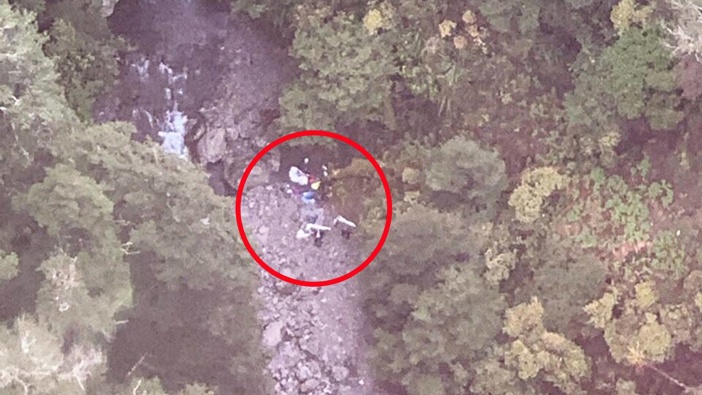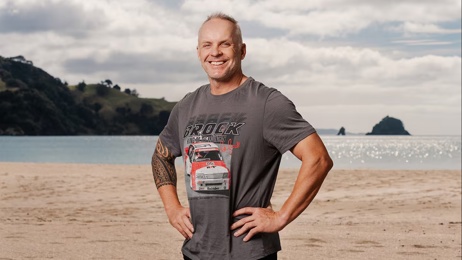Follow
the podcast on

The last thing Olly Dale remembers before seeing a rescue helicopter flying up the valley was having lost all feeling in his feet as he got colder and colder.
The 17-year-old, rescued along with three friends in the Ruahine Ranges on Sunday, later learned medics believed he was just an hour from death.
And his friends weren't much better off.
"They gave us two hours before they were lifting multiple bodies out."
The four Palmerston North teenagers, three of them Scouts, had taken off from Rangiwahia in the lower North Island bush and stayed in a DoC hut on Saturday night.
Much of the area had no cellphone reception so Dale decided to take a personal locator beacon (PLB) with him.
It was a decision that probably saved his life.
Dale, two fellow Freyberg High School graduates and a Longburn Adventist College school leaver spent Saturday night at the six-bunk Triangle Hut.
It rained all night and they woke early on Sunday before heading to the Oroua River where they had to cross waist-high water.
The downpour returned at about 11am and they decided to take a rest on a step bank as it was becoming increasingly unsafe zig-zagging their way across the river.
Dale and his friend Lachlan, 18, went off to find a possibly safer spot. They did so hoping the 17-year-old girls Meghan and Esther could get some rest and shelter.
The teenagers had tents and emergency blankets.
"We were still on the edge of the river. We saw across the river there was a flat, sandy spot," Dale said.
"We started walking again... We were all confident we could do it but of course everyone was cold, tired and miserable. We were just trying to get on with it."
"So we walked about another 100m down the river where I just started to stop the group and do a hypothermia check. I could see I was starting to get hypothermia."
Symptoms of hypothermia can include shivering, exhaustion, clumsiness, fumbling hands and confusion.
"We stopped and we put our gas cooker on and boiled some water."
The group made hot Raro out of the flavoured drink sachets. But the situation was increasingly grim, and Dale eyed up the locator beacon.
"I had it in my hand and I pretty much sat around and laid out the facts."
A majority were in favour of setting it off - but it was still a big call to make.
The beacons send an exact location to emergency services, emitting a distress signal.
Beacons must be registered with the Rescue Co-ordination Centre of New Zealand, which takes charge of land-based missions following a PLB activation.
Dale remembered thinking: "Right, I'll do one last vote."
This time, the verdict was unanimous. Now, it was a matter of waiting, and hoping.
"My condition started to worsen," Dale said.
Soon he couldn't feel his feet at all. He later learned he was drifting in and out of consciousness.
"The next thing I remember after that is we had the helicopter coming up the valley."
The Lowe Corporation Rescue Helicopter from Hawke's Bay approached.
The four teens used their shiny emergency blankets to ensure the chopper's intensive care paramedic Ryan Sutherland and his colleagues could see them.
But with hail belting down, the helicopter moved away. The group didn't know what had happened. But the rescuers soon reappeared in the dense bush.
Dale said Sutherland approached.
"I remember him telling us we're all right and we're not in trouble."
"They walked us up to the spot where they could pick us up and they put us into a type of bag or harness, one at a time."
Dale and one of the 17-year-old girls were in the worst condition, so were flown out first to Palmerston North Hospital.
The Lowe Corporation crew dropped off supplies to the other two trampers to tide them over.
Wrapped in blankets, Dale and his friend arrived at the hospital where his parents were waiting.
The relief was overwhelming. After three hours in hospital, Dale was free to go.
Then the reality of what happened set in after Dale, fully conscious, absorbed what rescuers and medics told him.
"They actually only gave me one hour left."
He credited Scouts training with making him prepared.
And he also said without the beacon, the best-case scenario would have been a very expensive search and rescue operation lasting days.
Rescue Co-ordination Centre NZ spokesman Keith Allen said it was more important than ever for people to carry locator beacons.
Sutherland agreed.
"It was great that they had the common sense to activate their beacon. It could've been the difference between life and death at that point.”
Take your Radio, Podcasts and Music with you









